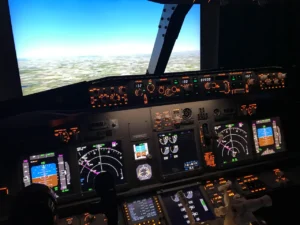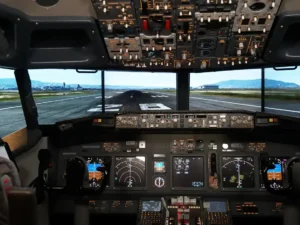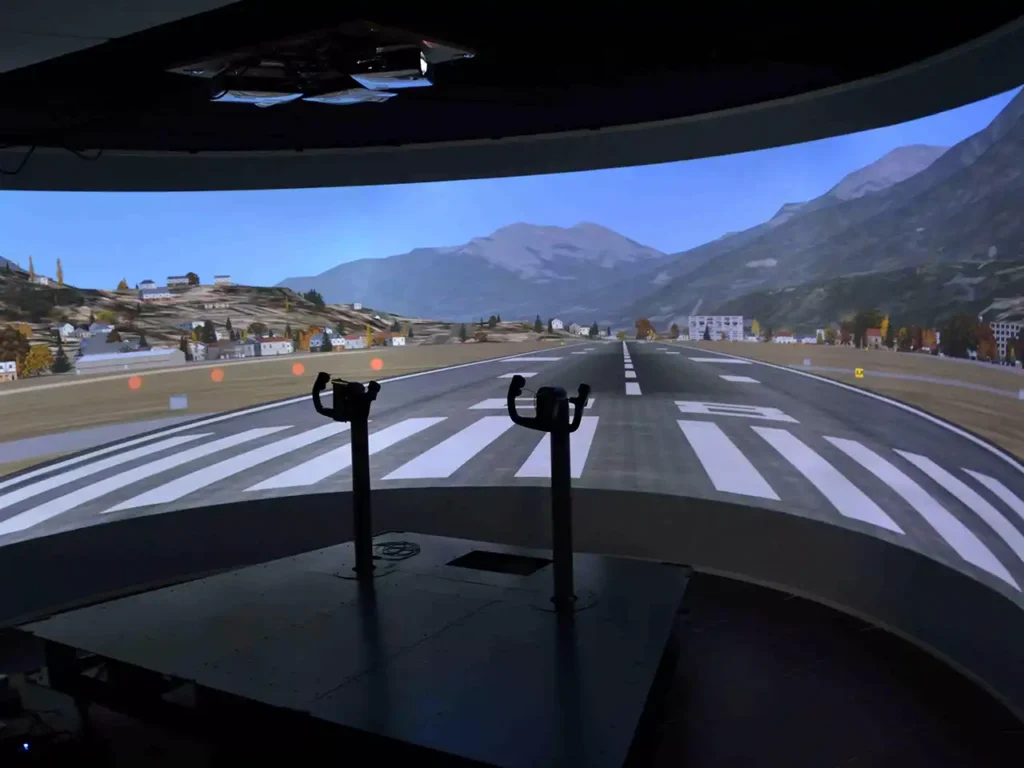Home flight simulators are commonly configured with either a single LCD display, three LCD displays angled around the flight deck, or three projectors that project the image to a curved screen.
Single Display vs. Three Displays
Using a single front display for a flight simulator is a reasonable option for building a simulator in stages, for the purpose of managing cost. However, the field of view will be significantly limited with a single display, especially if the displayed field of view is configured to be realistic.
Having multiple displays provides peripheral vision, which is powerful in creating an illusion of motion and realism. A Level D simulator uses massive hydraulic pistons to move the entire simulator for creating G-forces as well as roll or pitch attitudes. While I was training in a Level D simulator for my type rating, one time my instructor forgot to turn on the motion component. We were halfway through a two hour session before we realized that the motion was not turned on. Peripheral vision is powerfully effective into making the brain believe that you are in a real aircraft that is in motion.


If it is necessary to construct a flight simulator in stages, adding three displays should be done as soon as possible. The cost of this is relatively low in comparison to the huge gains achieved in realism.
This simulator uses three 63-inch LCD displays. They are mounted at a distance that maximizes the field of view. They are angled so that the from the eyepoint inside the flight deck, the distance to the center point of each screen is equal. They provide a 163º horizontal field of view and a 33º vertical field of view. This allows for full visual immersion from the viewpoint inside of the flight deck, when exterior field of view is constrained by the size of the flight deck windows.
LCD Displays vs. Projectors
There seems to be a significant difference of opinion regarding the use of large LCD TV displays versus using projectors with a curved white screen.
LCD TV displays are relatively inexpensive, even for extremely large displays. Projection systems are substantially more expensive because the specialized short-throw projectors are usually more expensive than an LCD TV.

Projectors require an extremely large curved white screen. Such screens are very specialized, expensive, and required a substantially larger room.
The images from each of the three projectors will overlap and special blending software will need to be used that makes the image from one projector seamlessly blend with the adjacent projector image. This software is specialized and has a significant cost, in additional to adding another demand on the main computer’s CPU processing.
LCD TV displays are capable of much greater dynamic range in darkness. In comparison, projectors create an image using projected light, so emulating the appearance of a dark sky during night flight or a dark runway is challenging.
LCD have a minor disadvantage of having a bezel on their edges. This would seem to be a major disadvantage, but it really is more of a minor disadvantage. The bezel widths of the displays for this simulator are 0.55 inches. When immersed in simulated flight, the bezels are simply not noticed unless your look for them. A realistic flight deck will have multiple windows, so the brain seems to automatically quickly disregard the loss of image for a small area.
A significant advantage of a projection system is that it allows the creation of a field of view that is naturally curved and sometimes can even exceed 180 degrees. In contrast, the field of view with LCD TV monitors is less. Even with optimal placement and large 65-inch size LCD TVs, the horizontal field of view is 163 degrees for this simulator.
Taking all these pros and cons into consideration, most home flight simulators use LCD TV displays, primarily due to cost, less complexity, and room space limitations.



